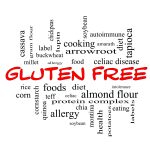Going Gluten Free?-What you need to know
 Many people are wondering whether they are gluten- intolerant or have coeliac disease. The information out there is varied and confusing. Often after blood tests, people are told they do not have gluten intolerance but know that bread makes them feel ill, so they feel perplexed. Here is a summary of what we know so far
Many people are wondering whether they are gluten- intolerant or have coeliac disease. The information out there is varied and confusing. Often after blood tests, people are told they do not have gluten intolerance but know that bread makes them feel ill, so they feel perplexed. Here is a summary of what we know so far
Coeliac disease
This is a disease with a big genetic component. It causes patches of inflammation on the lining of the small intestine when wheat is eaten. This causes abdominal pain, bloating and diarrhoea. Patients also get low on nutrients as the small bowel can’t absorb nutrients properly. Weight loss can be a problem too. The best way to diagnose this is by a gastroscopy with some biopsy samples. A blood test the TTG, is often negative, particularly if they have excluded wheat from their diet.
Non-coeliac wheat intolerance
For most people with symptoms, wheat alone is the problem and other grains are OK. The main protein in wheat is gliadin. Many people feel they can’t tolerate gliadin and get symptoms of IBS like pain, bloating, gas, diarrhoea or constipation or both. Their blood tests and gastroscopy may be negative. However, these patients know wheat in bread, pasta, baked goods etc makes them feel ill and when they remove it they feel better.
The Elimination and Challenge
In these cases, the easiest way to work out if wheat is a problem is to eliminate all wheat products for 1 month. This allows the gut to heal up and symptoms to settle down. Then follow that up with a 3 day challenge eating 6 slices bread per day or equivalent. If symptoms return then wheat intolerance is real and wheat should be avoided.
What’s the cause?
There could be several reasons, such as intolerance to gliadin itself. But wheat contains other chemicals such as phytates, saponins and lectins. These are bitter chemicals which act as natural pesticides while the seed is growing. Many wheat intolerant people are actually reacting to these chemicals rather than the wheat itself. A clue is that these patients can tolerate white or refined bread better than wholegrain.
Then there are the additives like bread improver 282. Some people are intolerant to these artificial preservatives. Getting bread which is free of 282 is often all that’s needed and some bakers and brands advertise that they are ‘282-free’.
Gluten-free – what does it mean?
Again there is a lot of confusion around this definition. Most products advertised as gluten-free are actually only wheat free. Gluten is contained in many other grains, even rice. But as the wheat gluten (gliadin) is most often the problem, these products remove wheat and gliadin but replace them with other grains such as millet, semolina, rice and tapioca. For many people, this is enough. But for some people, other grains also cause problems and they need to remove all grains from their diet.
Some products which are advertised as gluten-free such as spelt are made from wheat and are only low-gluten, not gluten-free. So there are many facts to know before you can navigate the gluten intolerance mine-field. Getting help from a trained food coach can ensure you get the right advice.

